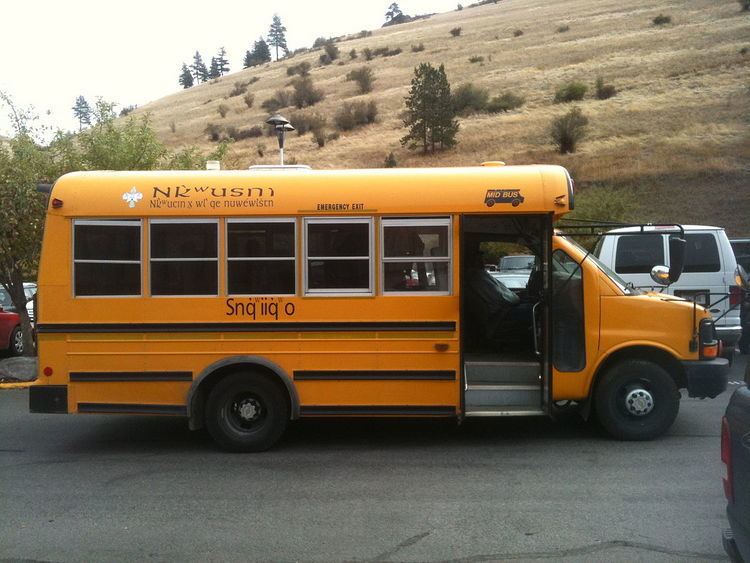Region Montana Glottolog kali1307 | Native speakers 66 (2005) | |
 | ||
Ethnicity 8,000 Pend d'Oreilles (Kalispel), Flathead, Spokane peoples (1977–1997) Language family Salishan
Interior Salish
Southern
Salish ISO 639-3 Either:
fla – Flathead
spo – Spokane | ||
The Salish or Séliš language /ˈseɪlɪʃ/, also known as Kalispel–Pend d'oreille, Kalispel–Spokane–Flathead, or, to distinguish it from the Salish language family to which it gave its name, Montana Salish, is a Salishan language spoken (as of 2005) by about 64 elders of the Flathead Nation in north-central Montana and of the Kalispel Indian Reservation in northeastern Washington state, and by another 50 elders (as of 2000) of the Spokane Indian Reservation of Washington. As of 2012, Salish is "critically endangered" in Montana and Idaho according to UNESCO.
Contents
Dialects are spoken by the Spokane (Npoqínišcn), Kalispel (Qalispé), Pend d'Oreilles, and Bitterroot Salish (Séliš). The total ethnic population was 8,000 in 1977, but most have switched to English.
As with many other languages of northern North America, Salish is polysynthetic; like other languages of the Mosan language area, there is no clear distinction between nouns and verbs. Salish is famous for native translations that treat all lexical Salish words as verbs or clauses in English, for instance translating a two-word Salish clause that would appear to mean "I-killed a-deer" into English as I killed it. It was a deer.
Language revitalization
Salish is taught at the Nkwusm Salish Immersion School, in Arlee, Montana. Public schools in Kalispell, Montana offer language classes, a language nest, and intensive training for adults. An online Salish Language Tutor and online Kalispel Salish curriculum are available. A dictionary, "Seliš nyoʔnuntn: Medicine for the Salish Language," was expanded from 186 to 816 pages in 2009; children's books and language CDs are also available.
Salish Kootenai College offers Salish language courses, and trains Salish language teachers at its Native American Language Teacher Training Institute as a part of its ongoing efforts to preserve the language. As of May 2013, the organization Yoyoot Skʷkʷimlt ("Strong Young People") is teaching language classes in high schools.
Salish-language Christmas carols are popular for children's holiday programs, which have been broadcast over the Salish Kootenai College television station, and Salish-language karaoke has become popular at the annual Celebrating Salish Conference, held in Spokane, Washington. As of 2013, many signs on U.S. Route 93 in the Flathead Indian Reservation include the historic Salish and Kutenai names for towns, rivers, and streams. The Missoula City Council is seeking input from the Salish-Pend d'Oreille Culture Committee regarding appropriate Salish-language signage for the City of Missoula.
Phonology
Salish has five vowels, /a e i o u/, plus an epenthetic schwa [ə] which occurs between an obstruent and a sonorant consonant, or between two unlike sonorants. (Differences in glottalization do not cause epenthesis, and in long sequences not all pairs are separated, for example in /sqllú/ → [sqəllú] "tale", /ʔlˀlát͡s/ → [ʔəlˀlát͡s] "red raspberry", and /sˀnmˀné/ → [səʔnəmˀné] "toilet". No word may begin with a vowel.
Salish has pharyngeal consonants, which are rare worldwide and uncommon but not unusual in the Mosan Sprachbund to which Salish belongs. It is also unusual in lacking a simple lateral approximant and simple velar consonants (/k/ only occurs in loanwords), though again this is known elsewhere in the Mosan area.
The post-velars are normally transcribed as uvular consonants: ⟨q, qʼ, χ, qʷ, qʷʼ, χʷ⟩.
Salish contrasts affricates with stop–fricative sequences. For example, [ʔiɬt͡ʃt͡ʃeˀn] "tender, sore" has a sequence of two affricates, whereas [stiʕít.ʃən] "killdeer" has a tee-esh sequence. All stop consonants are clearly released, even in clusters or word-finally. Though they are generally not aspirated, aspiration often occurs before obstruents and epenthetic schwas before sonorants. For example, the word /t͡ʃɬkʷkʷtˀnéˀws/ "a fat little belly" is pronounced [t͡ʃɬkʍkʍtʰəʔnéʔʍs]; likewise, /t͡ʃt͡ʃt͡sʼéˀlʃt͡ʃn/ "woodtick" is pronounced [t͡ʃt͡ʃt͡sʼéʔt͡ɬʃᵗʃən], and /ppíˀl/ is [pʰpíḭᵗɬə̥].
Morphology
Given its polysynthetic nature, Salish-Spokane-Kalispel encodes meaning in single morphemes rather than lexical items. In the Spokane dialect specifically, the morphemes ¬–nt and –el’, denote transitivity and intransitivity respectfully. Meaning, they show whether or not a verb takes a direct object or it does not. For example, in (1) and (2), the single morphemes illustrate these properties rather than it being encoded in the verb as it is in English.
(1) ɫx̥ʷntén ‘I made a hole in it’.
//ɫox̩ʷ-nt-en// open(ed)-TRANS-1 sg. subj.(2) pllstél ‘He got to kill (one)’
//puls-VC-st-el'// die, kill-OC-TRANS-SUCCESSSomething that is unique to the Spokane dialect is the SUCCESS aspect morpheme: -nu. The SUCCESS marker allows the denotation that the act took more effort than it normally would otherwise. In (3) and (4) we can see this particular transformation.
(3) ɫp'ntén ‘I marked it
//ɫip'-nt-en// mark-TRANS- 1 sg. subj.(4) ɫp'nún ‘I had a hard time marking it’
//ɫip'-nu-nt-en// mark-SUCCESS-TRANS- 1 sg. subj.The SUCCESS aspect and an OUT-OF-CONTROL morpheme reduplication, found in other Native languages, are commonly found together in Spokane Salish. An OUT-OF-CONTROL reduplication morpheme denotes that the action was done by accident. Below, (5), (6) and (7) exemplify this.
(5) ɫuʔntén ‘I stabbed it/him/her’.
//ɫuʔ-nt-en// stab-TRANS- 1 sg. subj.(6) ɫuʔnún ‘I managed to stab it/him/her’.
//ɫuʔ-nu-nt-en// stab-SUCCESS-TRANS- 1 sg. subj.(7) tuʔʔnún ‘I managed to stab it/him/her by accident’.
//tuʔ-VC-nu-nt-en// stab-OC-SUCCESS-TRANS- 1 sg. subj.The intransitive morpheme that describes extra effort is –el’. Barry Carlson states that:
"Spokane intransitive success forms, created with -el', emphasize that a subject's control requires extra effort in an event and they focus the duration of this effort well before the event beginning. This makes the predication a result. Thus, their true meaning can only be seen in a larger context."
That is to say, that for intransitive instances it is context driven and therefore extra context is needed in order to use the morpheme –el’. Example (8) derived from (1) illustrates this:
(8) pllstél’ ‘He got to kill (one)’
//puls-VC-st-el'// die, kill-OC-TRANS-SUCCESS šíč'l' u ʔax̩í u pllstél' he missed and finally and he got to kill (one) ‘He kept missing, but finally he got to kill (one)’